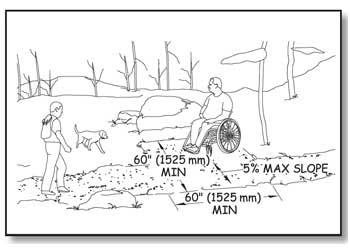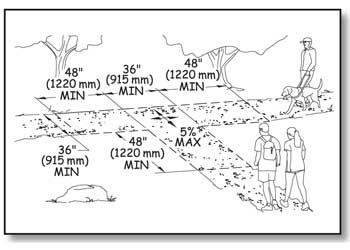Passing Spaces on Trails
A 60-inch (1,525-millimeter) clear tread width is required for two wheelchairs to pass safely and comfortably on a trail. However, this width is not always appropriate in all settings and for all trail classes. Where the clear tread width of a trail is less than 60 inches (1,525 millimeters), provide passing spaces at least every 1,000 feet (300 meters) and at the end of any segment of trail that meets the technical requirements, if the full length of the trail does not. Passing spaces must be at least 60 inches (1,525 millimeters) wide (including the trail width) by 60 inches (1,525 millimeters) long (figure 134). A T-intersection of two trails or other walking surfaces also may be used as a passing space if the arms and stem of the T-shaped space extend at least 48 inches (1,220 millimeters) beyond the intersection (figure 135). Either configuration would provide enough room for someone to move to the side. If a condition for an exception prevents achieving full compliance with the passing space requirements, the first general exception allows achieving passing space requirements to the extent practicable.

Figure 134—The requirements for passing spaces.

Figure 135—The requirements for passing spaces at T-intersections.

User Comments/Questions
Add Comment/Question